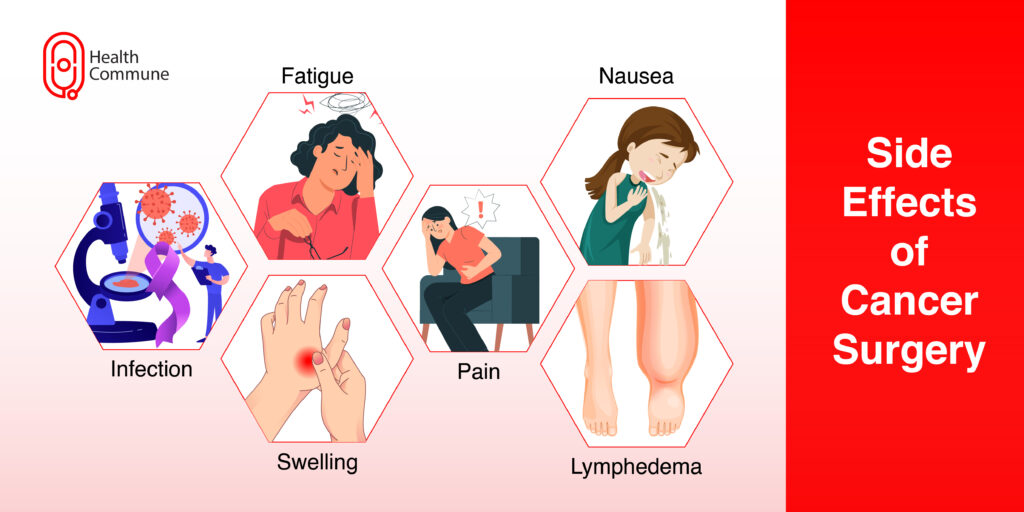The area of cancer treatment known as “surgical oncology” focuses on using surgery to identify, classify, and treat cancer and relieve some of its symptoms. As part of the patient’s treatment plan, surgical oncologists collaborate with a multidisciplinary team of doctors and clinicians to combine surgery with other therapies and procedures. This article provides a better understanding of what surgical oncology is, its goals, and its side effects.
What is surgical oncology?
What are the types of cancer surgeries?
Based on the goal of the cancer surgery, it is subclassified into different types.
Diagnostic surgery
- Performed to determine or confirm if the abnormal tissues are cancerous.
- In an excisional biopsy, the entire abnormal tissue is removed for microscopic examination
- An incisional biopsy involves the removal of a small sample of abnormal tissue for examination under a microscope
- Sometimes a Fine Needle Aspiration Cytology (FNAC) is performed, in which a needle may be inserted into the lump or cancerous area to remove a few cells for microscopic evaluation
Preventive surgery
- Commonly referred to as prophylactic surgery
- It is performed for the removal of potentially cancerous or precancerous tissues from the body
- Related therapies include mastectomy, which involves removing the breast to lower the risk of breast cancer. The ovary and fallopian tubes may also be surgically removed in those who are at high risk of developing ovarian cancer.
Staging surgery
- A surgical oncologist performs this operation to determine the stage of cancer.
- The staging surgery exposes the affected areas and determines the extent of cancer.
Curative surgery
- This is performed to remove the whole or part of tumour and other surrounding afflicted bodily tissues after the presence of cancer has been established and its stage determined.
- Curative surgery is performed when the cancer is localised to a particular area
- In extensive cancers, only a part of the tumour may be removed; this is called debulking surgery
Reconstructive surgery
- Reconstructive surgery is what would be needed to rebuild the body in order to restore body parts.
- For instance, facial reconstruction is required while treating head and neck cancer in order to restore the face
Palliative surgery
- In advanced cancer, there may be little chance of recovery. However, there are numerous ways to enhance the quality of life.
- Even though this surgery may not treat cancer, it helps reduce the discomfort caused by cancer or its treatment
- An example of this is the removal of part of a tumour that is impinging on the nerve or exerting pressure on vital structures, thus causing discomfort and pain.
Supportive surgery
- This surgery is performed to support other treatments that work effectively.
- It involves procedures such as surgery for the insertion of a catheter into the tumour for chemotherapy

Are there any contraindications for cancer surgery?
Although surgery is a successful therapeutic option for many cancers, it is not appropriate or recommended in certain conditions.
- Leukaemia: cancers affecting the blood cells
- Lymphatic system: cancers affecting lymph nodes and lymphatic vessels
- If cancer occurs in very delicate tissues or near vital organs, For example, if the cancer is present near the major blood vessels
- If the cancer has spread throughout the body
What are the methods for cancer surgery?
Two main methods of cancer surgery include
- Open surgery
- Minimally invasive surgery
Open surgery is a procedure in which a surgical oncologist makes a large incision, typically to remove a tumour completely or partially along with some of the surrounding healthy tissues (margins).
Minimally invasive surgical methods use a few tiny incisions and require a few stitches. The patient experiences relatively less post-operative pain, and healing occurs faster with minimal scarring. Hence, it allows for a shorter hospital stay and thereby minimises the cost of treatment.
Types of minimally invasive surgeries include
Laparoscopy
- A surgical oncologist creates small incisions through which a thin, flexible tube with a camera called a laparoscope is inserted into the surgical site
- The tiny surgical instruments are also inserted through the incision, and the surgery is performed with visual guidance from the camera
Robotic surgery
- It is similar to laparoscopy.
- Here, the surgeon controls the surgical instruments attached to the robotic arm through a computer console, in contrast to manually manipulating the instruments
- It allows more flexibility, better access, and greater visualisation of the structures being operated
Other less-invasive cancer surgeries include
Laser surgery
- A focused, high-intensity beam is used to destroy the cancerous tissues
Cryosurgery
- In this procedure, the surgeon uses liquid nitrogen to freeze and kill the cancer cells.
Electrosurgery
- It is a technique in which electrodes deliver electric current directly to the tumour cells without harming healthy cells.
Natural orifice surgery
- It is a type of surgery that involves inserting a tube containing surgical tools into the body’s natural orifice, such as the mouth or rectum.
- Surgery is performed with the assistance of a camera.
Nanoknife
- This process employs thin needles called nanoknife, which are inserted surgically or through the skin into the cancer tissue, which is otherwise difficult to access
- Electric current is passed through the needles, which creates small pores on the cancer cells, subsequently destroying them
What are the side effects of cancer surgery?
- Infection
- Swelling
- Fatigue
- Pain
- Lymphedema
- Nausea
How successful is surgery as a treatment for cancer?
The effectiveness of cancer surgery depends on the stage of the disease. If detected early, surgery helps in the complete removal of cancerous cells and adjacent damaged tissues. However, the successful removal of the cancerous cells becomes difficult if the disease has progressed to advanced stages.
Written By:

Dr. Keertana
A medical writer with a Doctorate in Pharmacy, she writes vividly about medicine and science. Read her contributions and writings about various healthcare topics.


